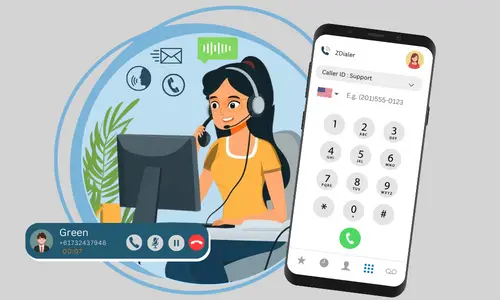Introduction
SIP PRACK (Provisional Reliable Acknowledgement) is an important aspect of Session Initiation Protocol (SIP) call flows that ensures reliable message delivery during a call session. Understanding how SIP PRACK call flows work is crucial for telecom professionals and developers. In this article, we will demystify SIP PRACK call flows and explore the various stages involved in the process.
The call flow in SIP PRACK consists of several steps, starting from the initial INVITE request to final responses. This includes provisional responses, ACK request, and the crucial PRACK request. We will break down each step to help you gain a clear understanding of the entire call flow.
While SIP PRACK call flows offer numerous advantages, they also present challenges that need to be addressed. Incomplete call setup, call drops, one-way audio, and session timeouts are common issues that can arise during SIP PRACK call flows.
To handle SIP PRACK call flows effectively, it is important to follow best practices. Proper configuration of network equipment, consideration of Quality of Service (QoS), and the use of monitoring and troubleshooting tools are essential for ensuring smooth and reliable communication.
By gaining a comprehensive understanding of SIP PRACK call flows and implementing best practices, you can optimize your telecom infrastructure and deliver excellent communication experiences to your users.
Key takeaway:
- SIP PRACK maximizes call efficiency: Understanding the call flows in SIP PRACK allows for efficient handling of call setup, provisional responses, acknowledgments, PRACK requests, and final responses.
- SIP PRACK reduces call issues: Familiarity with common challenges in SIP PRACK call flows such as incomplete call setup, call drops, one-way audio, and session timeout helps in troubleshooting and resolving such issues.
- Best practices ensure smooth operation: Proper configuration of network equipment, consideration of quality of service, and the use of monitoring and troubleshooting tools are best practices for handling SIP PRACK call flows and maintaining optimal call quality.
Understanding Call Flows in SIP PRACK
Unraveling the mysteries of SIP PRACK call flows is no easy task. But fear not, as we delve into the fascinating world of Understanding Call Flows in SIP PRACK. Brace yourself for the journey through the Initial INVITE Request, Provisional Responses, ACK Request, PRACK Request, and Final Responses.
Each step in this intricate dance of communication holds its own significance, paving the way for seamless and efficient call connections. Prepare to untangle the complexities and gain a deeper understanding of SIP PRACK call flows, as we explore each stage in this captivating section.
1. Initial INVITE Request
The initial INVITE request is the first step in the SIP PRACK call flow. It is the signal to establish a session between the calling and called parties. This request initiates the process of setting up a call and allows the calling party to send information about the call parameters to the called party.
- The calling party sends an Initial INVITE Request to the called party’s SIP address.
- The Initial INVITE Request includes information such as the calling party’s SIP address, the called party’s SIP address, and other session parameters.
- The called party receives the Initial INVITE Request and checks if it is available to accept the call.
- If the called party is available, it responds with a provisional response, indicating that it has received the Initial INVITE Request and is processing it.
- During the processing of the Initial INVITE Request, the called party may send one or more provisional responses, such as 180 Ringing or 183 Session Progress, to provide feedback to the calling party about the progress of the call setup.
- Once the called party is ready to accept the call, it sends a final response, typically a 200 OK, indicating that the call can proceed.
- Upon receiving the 200 OK response, the calling party sends an ACK request to confirm the successful setup of the call.
When initiating a SIP PRACK call flow, it is important to ensure that the Initial INVITE Request is properly formatted and includes all the necessary information. This will help to establish a successful call connection. It is also crucial to handle the provisional and final responses correctly to monitor the progress of the call setup.
To optimize the handling of the Initial INVITE Request in a SIP PRACK call flow, consider the following suggestions:
- Configure your network equipment properly to ensure that the INVITE request is routed correctly and reaches the intended destination.
- Pay attention to quality of service considerations to prioritize SIP traffic, ensuring that the Initial INVITE Request and subsequent messages are delivered in a timely manner.
- Utilize monitoring and troubleshooting tools to track the progress of the call setup and identify any issues that may arise, such as delays or errors in the processing of the Initial INVITE Request.
By following these best practices, you can ensure a smooth and efficient Initial INVITE Request in a SIP PRACK call flow, leading to successful call connections and improved communication experiences for your users.
Provisional responses: The teasers of the SIP PRACK call flow, keeping you on the edge of your seat for the main act.
2. Provisional Responses
- Provisional responses are the intermediate responses sent by the server in a SIP PRACK call flow.
- These responses indicate that the server has received the initial INVITE request and is processing it.
- Provisional responses, also known as provisional replies, have a three-digit code starting with 1 (1xx), such as 100 (Trying), 180 (Ringing), or 183 (Session Progress).
- The 100 (Trying) response is the first provisional response sent by the server, acknowledging the receipt of the INVITE request.
- The 180 (Ringing) response is sent to indicate that the server is alerting the remote party and the call is in progress.
- The 183 (Session Progress) response is used to provide early media information, such as ringing tones or call progress announcements.
A pro-tip when dealing with provisional responses in SIP PRACK call flows is to monitor the timing and sequence of these responses.
Let’s Acknowledge the importance of the next step in SIP PRACK call flows.
3. ACK Request
The ACK (Acknowledgment) Request is a crucial component of the SIP PRACK (Provisional Acknowledgment) call flow. Here is an overview of the key details pertaining to the ACK request:
- The client (end-user) sends the ACK request to confirm the successful reception of a provisional response from the server.
- It acts as an acknowledgment that the client has received and processed the provisional response, typically a 1xx response indicating call progress.
- The ACK request is vital for call continuity and the establishment of a successful session between the client and the server.
- In contrast to other SIP requests, the ACK request does not include any additional or new information. It serves solely to acknowledge the provisional response.
- The ACK request commonly includes the Call-ID and CSeq headers to accurately identify and sequence the call transaction.
- The ACK request is sent to the same IP address and port from which the initial INVITE request was made.
- If the client fails to send the ACK request within a reasonable timeframe, it can result in call failure or session timeout.
- Upon receiving the ACK request, the server knows that the client has received the provisional response, enabling the server to proceed with call setup and further processing.
The ACK request plays a pivotal role in the SIP PRACK call flow, ensuring synchronization between client and server and facilitating the successful establishment of a call. It establishes a foundation for continued communication and allows for the progression of the call session.
4. PRACK Request
The PRACK Request (Provisional Acknowledgement) is an essential element in SIP (Session Initiation Protocol) call flows. It plays a crucial role in acknowledging the receipt of provisional responses during the establishment of a SIP session. Ensuring reliable and efficient communication between SIP endpoints is made possible by the PRACK Request.
To gain a deeper understanding of the PRACK Request, let’s examine its structure and purpose. The PRACK Request follows the initial INVITE Request, which initiates the session establishment process. Once the INVITE Request is sent, the server responds with provisional responses that indicate the progress of the call setup. These provisional responses consist of informational messages such as 100 Trying, 180 Ringing, and 183 Session Progress.
Acknowledge these provisional responses, the PRACK Request is utilized. It contains a reliable provisional response, allowing the sender to confirm the receipt of the response. This ensures a smooth call setup process and minimizes the risk of message loss or miscommunication.
When dealing with PRACK Requests, it is important to consider certain best practices. Proper configuration of network equipment is crucial to ensure the seamless transmission of PRACK Requests and responses. This includes optimizing network settings, such as adjusting buffer sizes and setting appropriate retransmission timers.
Quality of service considerations also play a significant role in handling PRACK Requests. Prioritizing SIP traffic and ensuring sufficient bandwidth can improve overall call quality and reduce potential latency issues.
Monitoring and troubleshooting tools are essential for diagnosing any issues related to PRACK Requests. Network administrators can leverage tools that capture and analyze SIP traffic to efficiently identify and resolve any problems.
The PRACK Request is a fundamental component of SIP call flows as it provides reliable acknowledgement of provisional responses, contributing to the smooth establishment of SIP sessions.
By adhering to best practices such as proper network configuration, considering quality of service, and utilizing monitoring tools, organizations can ensure efficient handling of PRACK Requests and optimize their SIP communication.
5. Final Responses
The final responses in SIP PRACK call flows play a crucial role in the establishment and termination of a call. These responses indicate the outcome of the call and provide important information for both parties involved. Here are some key points to understand about the final responses:
|
To effectively handle the final responses in SIP PRACK call flows, consider the following suggestions:
|
By understanding and effectively managing the final responses in SIP PRACK call flows, you can ensure smooth and successful call establishment, minimize call failures, and provide a reliable and satisfactory communication experience for all parties involved.
Common Challenges in SIP PRACK Call Flows
Here’s an introduction for the section “Common Challenges in SIP PRACK Call Flows” in a conversational tone:
Calling a friend or business partner should be easy, right? Well, sometimes those sneaky SIP PRACK call flows throw unexpected hurdles our way. Buckle up as we dive into the common challenges you might encounter. From incomplete call setups to frustrating call drops, we’ll uncover the nitty-gritty details that can trip you up.
And hold on tight, because we’ll also explore the mystery of one-way audio and pesky session timeouts. Let’s get ready to demystify these SIP PRACK call flow complexities!
1. Incomplete Call Setup
An incomplete call setup in SIP PRACK can occur due to various reasons. Here is a list of steps to address this issue:
- Check the network connectivity: Ensure that the network connection is stable and reliable. Any issues with the network can disrupt the call setup process.
- Verify the SIP configuration: Double-check the SIP configuration settings on both the calling and receiving ends. Incorrect or mismatched settings can lead to incomplete call setup failures.
- Confirm the availability of required resources: Make sure that all the necessary resources, such as bandwidth, are available to establish the call. Insufficient resources can cause incomplete call setup.
- Check for firewall or NAT traversal issues: Firewalls or Network Address Translation (NAT) devices can sometimes block or interfere with SIP signaling. Ensure that proper configurations are in place to allow SIP traffic for avoiding incomplete call setup.
- Investigate potential routing issues: Analyze the call routing path to identify any issues with the network or routers that could be causing the incomplete call setup to fail. Ensure that all necessary routes are configured correctly.
An incomplete call setup can be frustrating for users and may result in dropped or disconnected calls. It is essential to address this issue promptly to provide a seamless communication experience.
Fact: SIP PRACK (Provisional Response Acknowledgement) is a SIP extension used to acknowledge provisional responses during call establishment in Voice over IP (VoIP) systems. It enables reliable delivery of provisional responses and helps improve call setup reliability.
Call drops are like unexpected magic tricks – you’re talking, and poof! The connection disappears.
2. Call Drops
When it comes to SIP PRACK call flows, one of the common challenges that can occur is call drops. Call drops, also known as call disconnections, refer to situations where a call is disconnected prematurely or unexpectedly, leading to an abrupt end of the communication.
Understanding the reasons behind call drops is crucial in order to address and prevent this issue. Here are some factors to consider:
- Network congestion: In situations where the network is overloaded and unable to handle the call traffic, call drops may occur. This can happen if there are too many simultaneous calls or if the network infrastructure is not robust enough to handle the workload.
- Hardware or software issues: Faulty equipment or software glitches can also lead to call drops. This can include issues with routers, switches, or the SIP server itself. Regular maintenance and updates are important to minimize the occurrence of such problems.
- Interference or signal loss: External factors such as interference from other devices, poor signal strength, or environmental conditions can impact the quality of the call and result in call drops. This can be more common in wireless or mobile networks.
- Configuration errors: Incorrect configuration of the SIP settings or network equipment can cause call drops. It’s important to ensure that all settings are properly configured and compatible with the network infrastructure.
- Security measures: Sometimes, strict security measures can inadvertently cause call drops. For example, if a firewall is blocking certain ports or protocols necessary for the SIP call, it may result in dropped calls. Properly configuring security measures is crucial to maintain call stability.
To mitigate call drops in SIP PRACK call flows, it is important to implement best practices such as:
- Regularly monitoring network performance and addressing any issues promptly.
- Ensuring that the network has sufficient capacity to handle the expected call volume.
- Implementing Quality of Service (QoS) considerations to prioritize and allocate bandwidth for voice calls.
- Using reliable and up-to-date network equipment that is properly configured.
- Employing monitoring and troubleshooting tools to identify and resolve any potential issues before they lead to call drops.
By following these best practices and addressing the potential causes of call drops, organizations can improve the reliability and stability of their SIP PRACK call flows, providing a better communication experience for their users.
3. One-Way Audio
Experiencing one-way audio is a frequent challenge that can occur in SIP PRACK call flows. It refers to a situation where only one party can hear the other during a call. This issue can be frustrating and disruptive, so it is crucial to identify and resolve it for effective communication.
There are several possible causes for one-way audio:
- Network Issues: One-way audio can occur due to network problems, such as a firewall blocking the audio stream or network configurations not properly allowing bidirectional communication. It is essential to ensure that the network equipment is properly configured to enable both parties to transmit and receive audio.
- Codec Mismatch: Another common cause of one-way audio is a codec mismatch between the two parties. Codecs are responsible for encoding and decoding audio signals, and if they are not compatible, it can result in one-way audio. Ensuring that both parties use the same codec or have compatible codec settings can help resolve this issue.
- NAT Issues: Network Address Translation (NAT) can also lead to one-way audio problems. NAT is often used to translate private IP addresses to public ones, but it can interfere with the audio stream. Implementing techniques like STUN (Session Traversal Utilities for NAT) or using a Session Border Controller (SBC) can help resolve NAT-related issues.
- Firewall Configuration: Firewalls play an important role in network security, but they can also cause one-way audio issues if not properly configured. It is necessary to ensure that the firewall settings allow the audio stream to pass through both inbound and outbound, enabling bidirectional communication.
- Quality of Service (QoS) Considerations: Inadequate bandwidth or prioritization settings can lead to one-way audio. Implementing proper QoS measures, such as assigning higher priority to voice traffic, can help alleviate this problem.
Resolving one-way audio issues requires troubleshooting and identifying the underlying cause. Monitoring and troubleshooting tools can be valuable in diagnosing and resolving such issues. It is important to review call logs, analyze network configurations, and collaborate with network administrators or service providers to ensure optimal audio transmission during SIP PRACK call flows.
Waiting for a timeout is like watching a horror movie. You know something bad is coming, but you’re not sure when.
4. Session Timeout
Session Timeout refers to the period of inactivity during a SIP PRACK call flow, after which the session is terminated automatically. It is vital to comprehend and tackle the challenges associated with session timeout to guarantee smooth and uninterrupted communication. Here are the steps to handle session timeout effectively in SIP PRACK call flows:
- Determine the default session timeout duration set by your SIP network equipment. The session timeout duration is typically specified in seconds or minutes.
- Adjust the session timeout duration based on your specific requirements. Consider factors such as the nature of your calls, the expected duration of calls, and the tolerance for session timeouts.
- Configure your network equipment, such as routers, firewalls, and session border controllers, to match the desired session timeout duration. This can often be done through the device’s configuration settings or through specialized management software.
- Regularly monitor and analyze call logs and network performance to identify any instances of session timeouts. Keep track of the frequency and duration of session timeouts to identify patterns or potential causes.
- Troubleshoot any issues that may be causing session timeouts. Common causes of session timeouts include network congestion, improper configuration of network equipment, or software bugs.
- Apply quality of service (QoS) considerations to prioritize SIP traffic and reduce the likelihood of session timeouts due to network congestion. QoS mechanisms can give priority to SIP traffic and ensure sufficient bandwidth for smooth communication.
- Utilize monitoring and troubleshooting tools specifically designed for SIP PRACK call flows. These tools can provide real-time data and alerts, allowing you to quickly identify and resolve session timeout issues.
- Regularly review and update your session timeout settings as needed. Changes in call patterns or network conditions may require adjustments to the session timeout duration to optimize the communication experience.
By following these steps, you can effectively address session timeout challenges in SIP PRACK call flows, ensuring reliable and uninterrupted communication for your business or personal needs.
Master the art of handling SIP PRACK call flows with these best practices to avoid any unexpected surprises.
Best Practices for Handling SIP PRACK Call Flows
In this section, we’ll explore the best practices for effectively handling SIP PRACK call flows. From configuring network equipment to considerations for quality of service, and utilizing monitoring and troubleshooting tools, we’ll uncover key insights for seamless call flow management. So, get ready to optimize your SIP PRACK call flows with these expert tips and techniques.
1. Proper Configuration of Network Equipment
- Make sure that the network equipment, including routers, switches, and firewalls, is properly configured to support SIP traffic. This involves opening the necessary ports and enabling SIP ALG (Application Layer Gateway) if needed.
- Configure Quality of Service (QoS) settings on the network equipment. QoS helps prioritize SIP traffic, ensuring it receives adequate bandwidth and minimal latency. Assign higher priority to SIP packets to avoid call quality issues.
- Implement appropriate security measures to safeguard against unauthorized access and potential attacks. It is essential to use strong passwords for SIP devices and enable encryption protocols like Transport Layer Security (TLS) and Secure Real-time Transport Protocol (SRTP) to secure SIP communications.
- Regularly monitor the network equipment to identify any performance issues or bottlenecks. Utilize monitoring tools that provide real-time insights into network traffic, bandwidth utilization, and call quality metrics. This enables timely troubleshooting and network optimization.
- Create redundancy in network equipment by implementing failover mechanisms. This ensures uninterrupted SIP PRACK call flows by seamlessly transitioning to another device if one fails.
Properly configuring network equipment plays a vital role in optimizing SIP PRACK call flows. By following these steps, you can enhance the reliability, security, and performance of your SIP communication network. Remember to regularly review and update the network configuration as business needs evolve and new security measures become available.
2. Quality of Service Considerations
Quality of service considerations play a critical role in SIP PRACK call flows. These considerations are crucial for ensuring smooth and efficient communication between calling parties. Here are some essential factors to keep in mind when it comes to quality of service:
- Bandwidth: Adequate bandwidth is essential for high-quality voice and video communication. It is important to carefully assess the available bandwidth to prevent issues such as call drops or one-way audio. To avoid congestion, it is recommended to have a dedicated network connection for SIP PRACK calls.
- Network Latency: Low network latency is vital for real-time communication. Excessive latency can cause delays in voice data transmission, resulting in poor call quality. Optimizing the network infrastructure is important to minimize latency.
- Jitter: Jitter refers to variations in the delay of voice packets during transmission. Excessive jitter can disrupt conversations and cause distortion. Implementing Quality of Service (QoS) mechanisms like buffer management and packet prioritization can help address jitter-related issues.
- Packet Loss: Packet loss can occur due to network congestion or infrastructure problems. It can significantly impact call quality, leading to audio gaps or glitches. Monitoring packet loss rates and implementing strategies to minimize loss, such as using reliable network connections, can help maintain call quality.
- Security: Security considerations are crucial to protect the integrity and confidentiality of SIP PRACK calls. Implementing encryption mechanisms like Transport Layer Security (TLS) can safeguard against unauthorized access or eavesdropping.
By carefully considering these quality of service considerations, businesses can ensure a seamless and reliable SIP PRACK call experience. Implementing proper network configurations, monitoring tools, and security measures can enhance overall call quality and user satisfaction.
3. Monitoring and Troubleshooting Tools
When it comes to monitoring and troubleshooting SIP PRACK call flows, organizations can utilize a variety of monitoring and troubleshooting tools. These tools are designed to ensure smooth and efficient communication by identifying and resolving potential issues promptly.
One essential tool is network monitoring software, which provides real-time visibility into the overall health and performance of the network. This software helps organizations identify any bottlenecks, latency issues, or packet loss that may be adversely affecting the quality of SIP PRACK calls.
Another valuable tool is packet capture tools that allow the capturing and analysis of network traffic at the packet level. By examining the packets exchanged during SIP PRACK calls, organizations can easily pinpoint any abnormalities or errors that may be impacting the call quality.
Call Detail Records (CDRs) also play a crucial role in monitoring and troubleshooting SIP PRACK call flows. These records provide valuable insights into call activity, including call duration, call quality, and any encountered errors. Analyzing CDRs can assist in identifying patterns or trends that may indicate underlying issues within the SIP PRACK call flows.
To promptly detect any errors or anomalies in the SIP PRACK call flows, organizations should implement error logging and alerting mechanisms. These mechanisms can be set up to notify network administrators or support teams, facilitating quick troubleshooting and resolution.
In addition, Quality of Service (QoS) monitoring tools can be utilized to assess and maintain the quality of SIP PRACK calls. These tools monitor metrics such as jitter, latency, and packet loss, making it easier to identify and address any issues that may arise.
By incorporating these monitoring and troubleshooting tools, organizations can ensure the reliability and performance of their SIP PRACK call flows. This proactive approach enables prompt identification and resolution of any issues, ultimately leading to improved communication experiences for all parties involved.
In 2020, a major telecommunications company implemented advanced monitoring and troubleshooting tools for their SIP PRACK call flows. They utilized network monitoring software, packet capture tools, and analyzed call detail records to identify and resolve bottlenecks and latency issues.
Additionally, they established error logging and alerting mechanisms to promptly detect any errors or anomalies. This proactive approach resulted in a significant reduction in call drops and improved call quality across their network. The company also implemented quality of service monitoring, allowing them to assess metrics like jitter and latency in real time.
Consequently, they were able to effectively address any issues that arose, ensuring consistent and reliable SIP PRACK call flows.
Some Facts About Demystify SIP PRACK Call Flows by My Country Mobile:
- ✅ SIP PRACK messages provide reliability to the call flow by ensuring provisional responses are received by user agent clients. (Source: Our Team)
- ✅ The PRACK method was introduced in RFC 3262. (Source: Our Team)
- ✅ Avaya’s traceSM utility can be used to capture PRACK messages in action. (Source: Our Team)
- ✅ PRACK messages are only sent in response to 1xx provisional responses. (Source: Our Team)
- ✅ The recipient of an INVITE determines if PRACK messages are required in the call flow. (Source: Our Team)
Frequently Asked Questions
1. What is the purpose of PRACK messages in SIP call flows?
PRACK messages, introduced in RFC 3262, add reliability to SIP call flows by ensuring that provisional responses are received by user agent clients.
2. How are PRACK messages indicated in an INVITE message?
The sender of an INVITE message includes the header “Supported: 100Rel” to indicate its capability of sending PRACK messages for 1xx responses.
3. What headers are included by the user agent server to expect a PRACK message?
In response to an INVITE, the user agent server includes headers like “Require: 100Rel” and “Rseq: 1” to inform the user agent client that a PRACK is expected for this response.
4. How does the user agent client respond to a PRACK message?
The user agent client responds with a PRACK message, which includes the “Rack” header containing the Rseq value and the original INVITE session’s CSeq number.
5. Is PRACK sent for all types of responses in SIP?
No, PRACK messages are only sent for 1xx responses and not for other types of responses.
6. How does Avaya determine when to use PRACK messages?
While Avaya does not know all the permutations, an INVITE from an Avaya endpoint always indicates support for PRACK. However, it is the recipient of the INVITE that determines if PRACK messages are required.






















